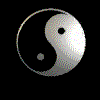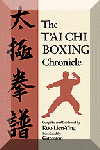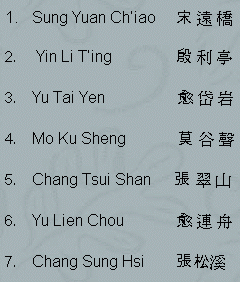


Also a
Spanish edition
The
Guang P'ing
T’ai Chi Page

History
![]()
The
history of the Guang P’ing T’ai Chi Ch’uan is ancient.
It is derived from the original Wu Tang ![]() system originating from Chang San Feng
system originating from Chang San Feng ![]() on Wu Tang mountain.
In the Sung family chronicles it is written that the oldest know
records of this specialized skill are from the T’ang dynasty.
This information was recorded by Hsu Hsuan P’ing
on Wu Tang mountain.
In the Sung family chronicles it is written that the oldest know
records of this specialized skill are from the T’ang dynasty.
This information was recorded by Hsu Hsuan P’ing ![]() nicknamed Yu
Huan Tze
nicknamed Yu
Huan Tze
![]() who taught Wu Tang style T’ai Chi.
There were a lot of masters in every dynasty but the most famous
were seven masters who lived before the time of Chang Sung Hsi
who taught Wu Tang style T’ai Chi.
There were a lot of masters in every dynasty but the most famous
were seven masters who lived before the time of Chang Sung Hsi ![]() .
Their names are listed as follows:
.
Their names are listed as follows:



The
original set was in accordance with the ideas of the Pa Kua ![]() and Wu Hsing
and Wu Hsing ![]() , and it was arranged into
thirteen sections called the thirteen forces. The new set uses more hand
movement but is often contrary to the principles of the boxing art. You
can accept or reject the new method or the Wu Tang method but don't dare to
reach a conclusion too quickly. It is not easy to distinguish whether the
movements are the real moving energy
, and it was arranged into
thirteen sections called the thirteen forces. The new set uses more hand
movement but is often contrary to the principles of the boxing art. You
can accept or reject the new method or the Wu Tang method but don't dare to
reach a conclusion too quickly. It is not easy to distinguish whether the
movements are the real moving energy ![]() of the
boxing art. In the chronicles of the honorable Ch'en family, all the key points
are made clear and the text is long. There is not one chapter which does
not mention Ch'en Ch'ang Hsing's Wang chronicles. We really don't know
which dynasty Wang Tsung Yueh
of the
boxing art. In the chronicles of the honorable Ch'en family, all the key points
are made clear and the text is long. There is not one chapter which does
not mention Ch'en Ch'ang Hsing's Wang chronicles. We really don't know
which dynasty Wang Tsung Yueh ![]() was born
in. Some say Ming some say Ch'ing, but hand-written documents say both so
there is no way of knowing.
was born
in. Some say Ming some say Ch'ing, but hand-written documents say both so
there is no way of knowing.
Study
and research the essentials of Wu Tang boxing. The rules and principles
are for practical use. All of the books; Sung ![]() ,
Wang
,
Wang ![]() , Ch'en
, Ch'en ![]() ,
Yang
,
Yang ![]() , Li
, Li ![]() ,
and Huang
,
and Huang ![]() contain priceless information.
Try to grasp the principles and attain the real usage of their profound
meaning. Then, like following the footprints of history, enter the gate of
the method
contain priceless information.
Try to grasp the principles and attain the real usage of their profound
meaning. Then, like following the footprints of history, enter the gate of
the method ![]() .
How to make use of the spirit of vitality is pointed out.
Combined, these books are without defect. Think and meditate on these six
books which record the sets and their structure. Don't decide too quickly;
be absolutely sure. Are the teachings the same or not? The old set
and the new set are different but both will be passed down for a thousand years!
.
How to make use of the spirit of vitality is pointed out.
Combined, these books are without defect. Think and meditate on these six
books which record the sets and their structure. Don't decide too quickly;
be absolutely sure. Are the teachings the same or not? The old set
and the new set are different but both will be passed down for a thousand years!
If
you deviate from the main road, you will not get the full benefit of T'ai Chi
boxing's Wu Tang school. There is a total of one hundred chapters written
by the six families above. The first chapter outlines T'ai Chi boxing, and
the second chapter is the Wang chronicle, called Kung Hsin Chieh ![]() .
These two chapters guide one in evaluating progress. They
completely explain the uses of the spirit of vitality which is learned through
push hands. You cannot disregard the rules. What is left behind from
the oldest time until now is a boxing art to assimilate. Understanding
these two chapters creates an indomitable person. Research and study these
two chapters, which are the creation of the principles. There it
says: There are many misleading ways of teaching the art and skill of
boxing. Although differing from one another, they all share a common
principle which is that the strong beat the weak and the slow yield to the
fast. These are theories not based on true knowledge and philosophical
research. It is obvious that strength alone does not explain a thousand
pounds toppled over with a trigger force of four ounces. When an old man
defends himself against a number of young people, something more than mere
strength and speed is involved.
.
These two chapters guide one in evaluating progress. They
completely explain the uses of the spirit of vitality which is learned through
push hands. You cannot disregard the rules. What is left behind from
the oldest time until now is a boxing art to assimilate. Understanding
these two chapters creates an indomitable person. Research and study these
two chapters, which are the creation of the principles. There it
says: There are many misleading ways of teaching the art and skill of
boxing. Although differing from one another, they all share a common
principle which is that the strong beat the weak and the slow yield to the
fast. These are theories not based on true knowledge and philosophical
research. It is obvious that strength alone does not explain a thousand
pounds toppled over with a trigger force of four ounces. When an old man
defends himself against a number of young people, something more than mere
strength and speed is involved.
These are the circumstances from which the T'ai Chi boxing principles were created. One studies theory in order to overcome brute force. The skill of the weak beating the strong must be forged in method. First there are restrictions in movement, afterwards the principles are the only restrictions. The boxing chronicles include everything in their sphere. Do not disregard this science!
![]()
The
Question of the Hard and Soft - ![]()
Is the T'ai Chi method soft and without strength? Can The internal energy come out this way? From ancient times it has been asked whether T'ai Chi boxing has only this soft practice method, or are the teachers generally unwilling to teach the secrets? We need to study and research these questions. Don't hesitate to raise questions for all to discuss. From the beginning until now, one question continues to come up. Is the T'ai Chi boxing method completely soft? Or is it hard and soft?
According
to Wang Chiao Yu, the famous teacher, there were two branches of T'ai Chi
boxing. One was called Guang Ping and the other was called Pei
Ching. Both are from the teachings of Yang Pan Hou. The Guang Ping
school's most famous descendent was Ch'en Hsiu Feng ![]() .
Ch'en Hsiu Feng served Pan Hou in the city of Pei Ching. He observed the
Pei Ching school and the Guang Ping school. They are not in the least
alike. He confidentially asked Pan Hou to differentiate between the
schools. The Guang Ping school has hard and soft. Is the Pei Ching
school completely soft?
.
Ch'en Hsiu Feng served Pan Hou in the city of Pei Ching. He observed the
Pei Ching school and the Guang Ping school. They are not in the least
alike. He confidentially asked Pan Hou to differentiate between the
schools. The Guang Ping school has hard and soft. Is the Pei Ching
school completely soft?
Yang Pan Hou first smiled and said, "Among the Pei Ching school there are many honorable men, but they practice boxing out of curiosity and play. Compared to the Mongol the nature and constitution of the body is dirrerent. The Mongol is not a Han. Do you understand?" Ch'en Hsiu Feng gave his deepest regards for this talk and he didn't dare to ask more. In those days the Manchus ruled China. They oppressed and killed and took everything to its most bitter extreme. All were men of China. Who could not bear a grudge in the heart? But there were those clear-headed men who know how to make use of the Manchus. In those days the Yang family was employed in the service of the Ch'ing dynasty. They managed the practice and teaching of the war arts for the Manchus. Who could believe that the Yang family should teach compatriots to kill each other? But Pan Hou did not teach them everything -- only enough to learn T'ai Chi boxing's form. He did not teach them the T'ai Chi boxing method or Achievement. He taught them to be soft as cotton but not how to acquire the astounding skill, so that they would not kill each other. He put them in a passive mode and compelled the royal families to get absorbed in mysticism so they would endlessly pursue an illusionary achievement.
In those days, the Yang family did teach some villagers the Guang Ping style. Then during training they used the hard and soft method at the same time. Pan Hou trained their strength properly in accordance with T'ai Chi boxing's "Kung Hsin Chieh", which says: Extreme softness and afterwards extreme hardness. First to expand and then contract. This answered Ch'en Hsiu Feng's uncertainty. This helped him to search out the meaning. The Yang family said, "In Pei Ching there are many honorable men but they practice boxing out of curiosity and play. You can see that the royal families have bodies like golden cups and jade leaves. They have not tasted hardship! They practice with the intention of showing off their fashionable inner strength and that is all". Pan Hou also said: "Mongols are not Han, do you understand? The distinction between these men is very clear. One type of man learned the difficult way, properly. Can you distinguish?" So, the Pei Ching school is completely soft, and the Guang Ping school has hard and soft. The practice methods are different. We can believe and rely on Yang Pan Hou's explanations to Ch'en Hsiu Feng. The advice of Pei Ching's Wang Chiao Yu and Yang Pan Hou is recorded, because they were masters. Let them explain T'ai Chi boxing from their records. If you don't receive the real teaching of T'ai Chi boxing, then you can only get a strong body. You can practice boxing for ten or more years and in the end only be confused. You can assume that the real teaching is hard to get. If you practice in accordance with ordinary methods, you will cultivate a strong body, which is more than enough, but if you want to succeed in the real power of T'ai Chi and become perfect, then you must receive the TRUE TEACHING. You must define this mysterious method; otherwise you will practice for years and in the end still be confused, because you couldn't practice out the real skill, your heart must look into a clear mirror. That way, in addition to T'ai Chi boxing's soft outer form you can completely understand the method. Now we will continue to discuss how to practice.
We already introduced Yang Pan Hou. Pan Hou and his brother Yang Chien Hou followed their father Yang Lu Chan and his boxing practice from early childhood. It was toilsome and difficult and they wanted to escape. They were tired and discouraged and thought about becoming Buddhist monks. The two of them just could not stand the pain and suffering of practice. In those days to practice was to endure hardship and to be determined. It was not just a soft boxing style.
Regarding the question of the hard and soft, Master Wang Chiao Yu once gave an explanation: "If you only desire to cultivate a healthy body then do a soft practice. It will give vitality and benefit the body and mind. If you want martial arts, on one hand you must know how to be soft to neutralize the enemy, and on the other hand you must know how to be hard to attack the enemy". Hard and soft must be combined to attain this function. If you want to attain this skill, then you must do a bitter practice, and receive instruction from a qualified teacher. Mr. Wang Chiao Yu and his teacher Yang Pan Hou, taught boxing in a way which was at first very bitter. But in the present day it is different. It is made easy. Ordinary men just can't stand the old way of learning. You must practice boxing like you want to succeed in getting the real skill and create a perfect body. If you only rely on the soft and don't use strength, like duckweed floating on water, the practice method is not going to succeed.
More to follow